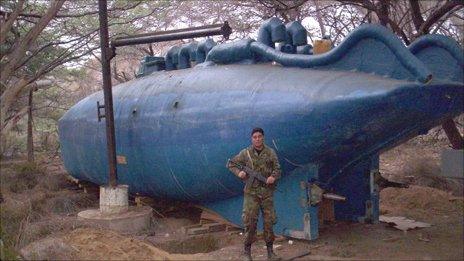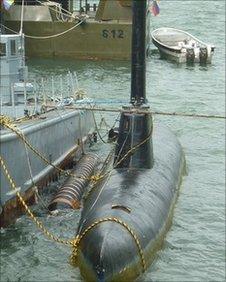Drug submarines: Colombia's underwater cocaine traffic
- Published

The vessels are often made from simple hardware shop materials - fibreglass, wood and plastic tubing
Colombia is the centre of the world's cocaine trade, and traffickers are always seeking new ways to avoid detection - including going underwater.
Nowhere is this more evident than at Colombia's Bahia Malaga naval base, on the Pacific coast.
The main pier is packed with captured fishing trawlers and high-speed cigarette boats once favoured by traffickers.
But there are also a handful of enclosed vessels with pipes and snorkels sticking out at odd angles.
Don't let the unconventional design fool you. These so-called semi-submersibles were built to transport tons of cocaine.
The vessels travel just below the surface of the water - only air and exhaust pipes, plus a navigational dome, stick out.
They leave tiny wakes and are extremely difficult to spot. They are also low-cost.
After making drug deliveries off the Mexican coast, traffickers scuttle the semi-subs because that is cheaper and safer than taking them back to Colombia.

This sub docked at Bahia Malaga has bunk beds and a satnav system
Recently, US and Colombian authorities have got better at detecting the semi-subs, and that has led to another technological innovation in cocaine smuggling.
Last year, for the first time, authorities captured a fully submersible submarine.
Then, in February, Colombian authorities discovered a second drug sub under construction.
That vessel is docked at the Bahia Malaga naval base. Inside it, Navy Lt Fernando Monroy points to a 345-horsepower diesel engine and tanks that can hold 1,700 gallons (6,435 litres) of fuel.
The submarine also carries ballast and compressed air tanks, bunk beds, a satellite navigation system, and a night-vision camera.
Finally, there's a storage compartment in the bow with space for eight tonnes of cocaine.
'Hellish' conditions
"We believe the smugglers will keep improving the technology, allowing them to make all their trips underwater," Lt Monroy says.
Colombian officials believe the submarine took several months to build, and cost about $4m (£2.4m), although it is hardly state-of-the art.
The 70-ft-long (21m) body was fashioned from supplies you could buy at a hardware store: fibreglass, wood, and plastic tubing.
Many cocaine traffickers are based in the Pacific port of Buenaventura, where poverty and unemployment are high.
A Colombian fishing boat captain said he made three trips to Mexico at the helm of drug-laden semi-subs, earning $300,000 a trip.
He described living conditions during those two-week voyages as "hellish" - there was no toilet and vapours from excrement, cocaine and diesel made it difficult to eat, sleep and breathe.
The captain, who asked not to be identified, said the vessel rarely stopped because stationary semi-subs are easier to detect.
Dramatic change
According to Jay Bergman, who heads the US Drug Enforcement Administration's Andean division, subs have created a whole new challenge in the battle against drug smuggling.
"Without question, it has us all going back to the textbooks and the drawing boards and figuring out what are we going to do about this," he said.
.jpg)
The crew of this vessel sank it after being detected by the US coast guard
Mr Bergman pointed out that so far, no drug submarines have been detected under the sea, but seizures of semi-submersibles have dropped dramatically in the past two years.
That could mean that traffickers have already made the switch to submarines - and that they are evading detection.
"For the analyst looking at emerging threats," Mr Bergman said, "when they see this precipitous drop in semi-submersibles and then the advent of these two submarines, there's a concern that's raised. What are we missing?"
US and Colombian officials said they will seek to target the submarines, but in the meantime, there's no shortage of people willing to risk their lives on board the drug subs.
The captain said he was recently offered $500,000 to make another trip to Mexico, but he turned it down.
"I told them: 'Thank you very much. I wish you all the luck in the world. But I'm not interested.'"
- Published15 February 2011
- Published4 July 2010